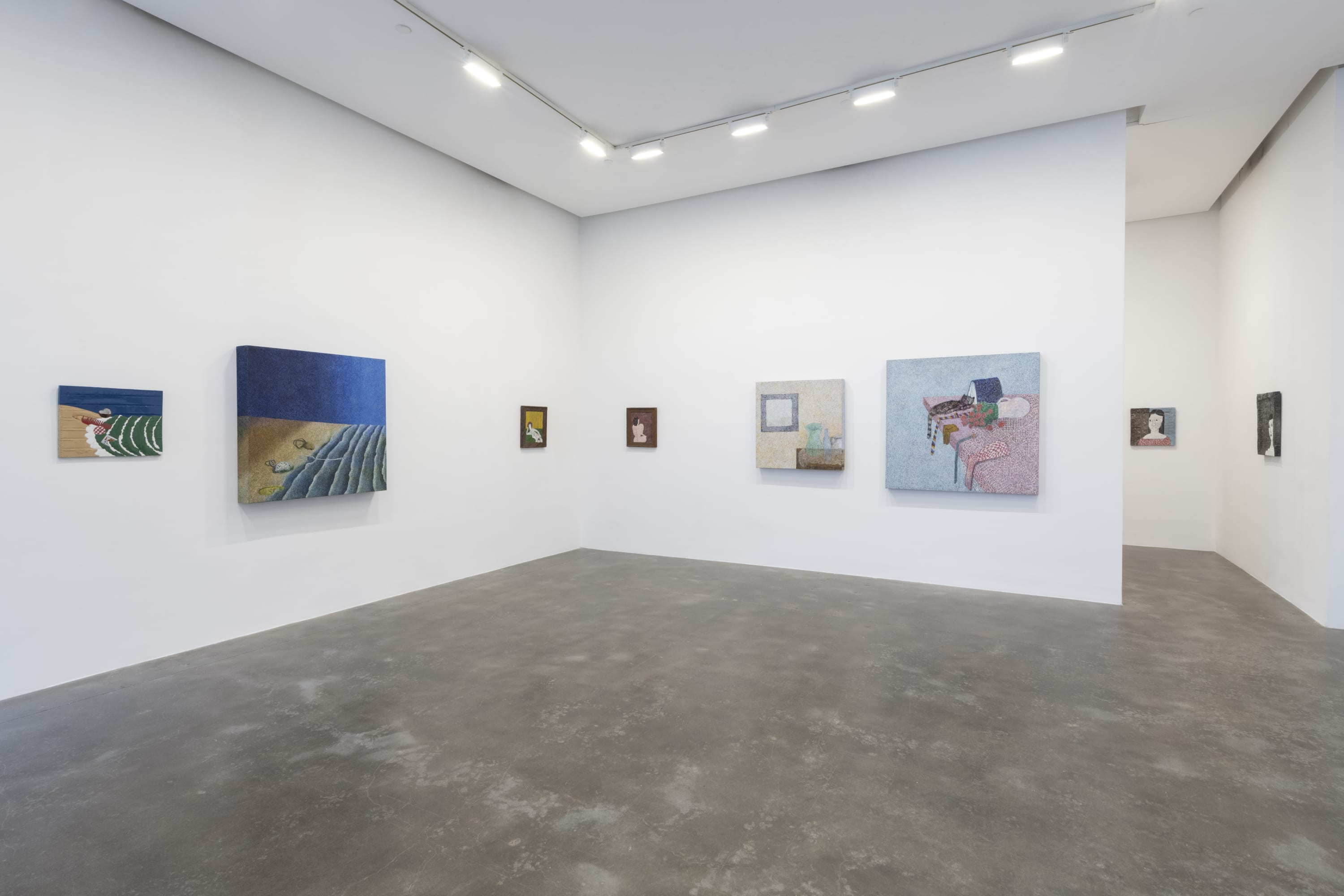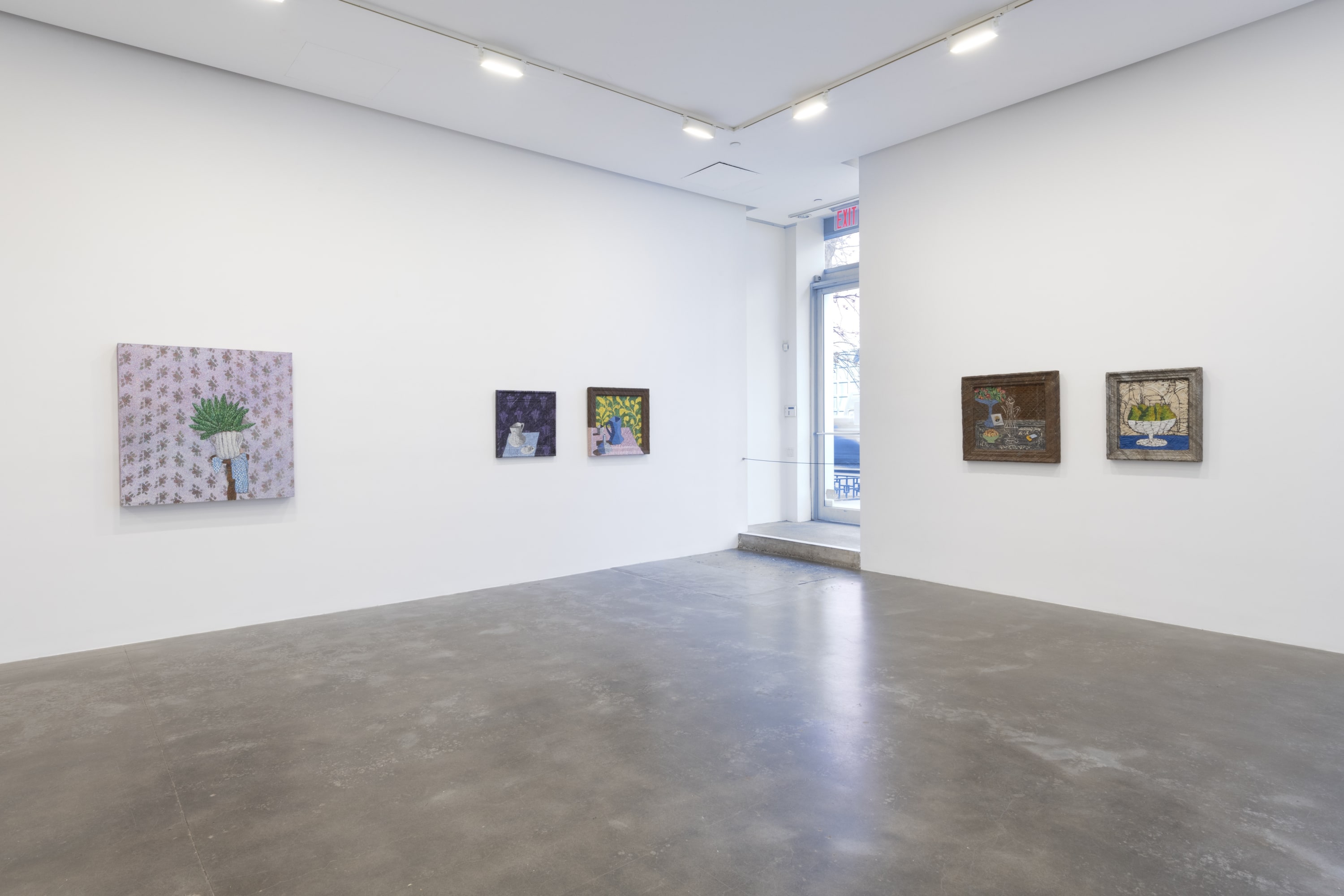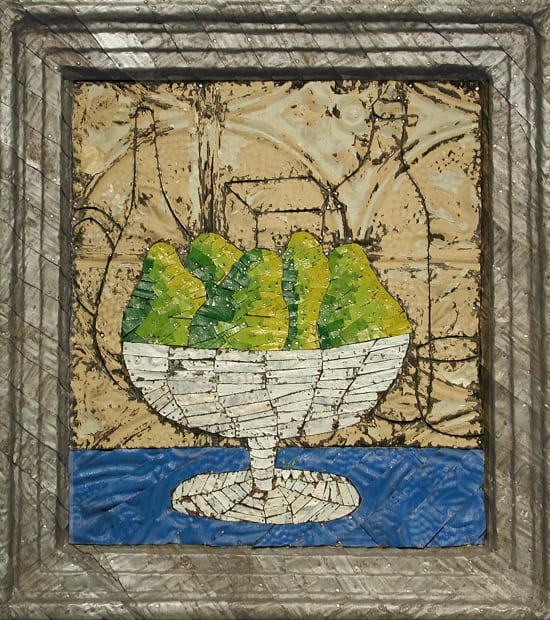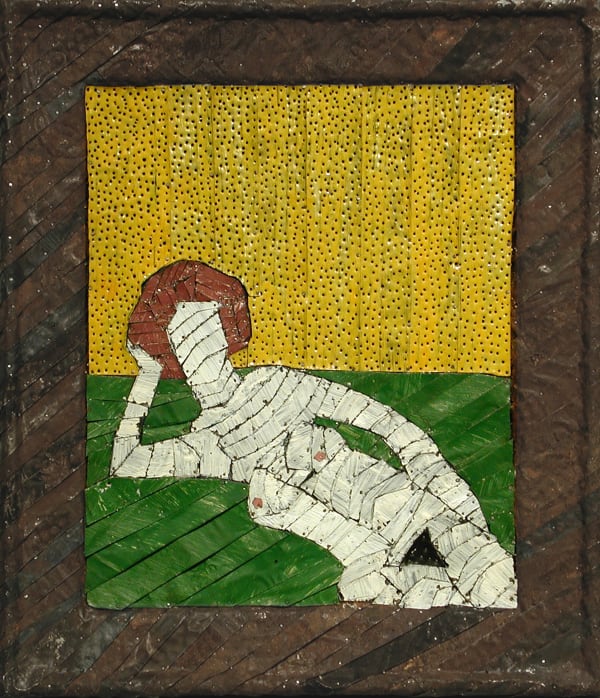-
ROBERT KOBAYASHI: PAINT AND TIN
-
Susan Inglett Gallery is pleased to present Robert Kobayashi (1925-2015) in his second exhibition with the Gallery. Paint and Tin represents a focused survey of works by the SoHo outlier artist, who transformed painting and tin into pointillist pictures and sculptures. The show will run from 16 March to 15 April, 2023.
-
INSTALLATION VIEW OF ROBERT KOBAYASHI: PAINT AND TIN AT SUSAN INGLETT GALLERY. PHOTO: ADAM REICH
-
The exhibition, Paint and Tin, was selected by the artists Juan Iribarren and Gallery represented artist Beverly Semmes, each of whom rented space from Robert Kobayashi at 237 Elizabeth Street, Moe’s Meat Market, where he lived, worked, and displayed his art. These artistic adjacencies and a sense of friendship for “Kobi” and his family bring a fresh perspective to the work of the artist, who passed away in 2015 at the age of 90.
-
 ROBERT KOBAYASHI, RUSSIAN HISTORY, 2001
ROBERT KOBAYASHI, RUSSIAN HISTORY, 2001 -
INSTALLATION VIEW OF ROBERT KOBAYASHI: PAINT AND TIN AT SUSAN INGLETT GALLERY. PHOTO: ADAM REICH
-
 ROBERT KOBAYASHI, HAPA HAOLE, 2008
ROBERT KOBAYASHI, HAPA HAOLE, 2008 -
This presentation of Kobayashi’s classical art subjects — still lifes, landscapes, portraits and nudes — seen here in pairs and in groups — underscores the artist’s open spirit and range. Juan Iribarren and Beverly Semmes worked closely with the artist’s wife Kate Keller Kobayashi and their daughter Misa Kobayashi to choose work for this exhibition. Their intimate perspective highlights Kobayashi’s process as he moved between his dual techniques of painting and tin “clouage.”
-
The following is an interview between Susan Inglett Gallery Press Liaison Cortney Connolly and Gallery represented artist Beverly Semmes and Juan Iribarren. Here, the curators reflect on their inspirations, artistic practices, processes, and time spent with Kobayashi at Moe's Meat Market.
-
 ROBERT KOBAYASHI, COMB ON BEACH, 1980
ROBERT KOBAYASHI, COMB ON BEACH, 1980 -

ROBERT KOBAYASHI, UNTITLED (BUREAU WITH LACE), 2009-10
-
 ROBERT KOBAYASHI, VASE WITH PEARS, 1987
ROBERT KOBAYASHI, VASE WITH PEARS, 1987 -
Aside from you two, who else was renting studio space? How did this community of artists influence one another?
BS: A number of creative people lived and worked in the building: Juan, George Trakas, Patrick Neal, David Hotson, Liz Bigham, Erik Landsberg, Geanna Merola and Dave Allison. I think I was the only artist that shared a studio space with Kobi and Kate. The Kobayashis had many wonderful friends in the building and the neighborhood. Among them was Mary Albanese, whose brother was the Moe of Moe’s Meat Market. Mary was in her 90s while I lived on Elizabeth Street. She lived on the 5th floor and was a special presence in the life of the building.
-
 ROBERT KOBAYASHI, SEASCAPE, 1980
ROBERT KOBAYASHI, SEASCAPE, 1980 -
How long did you remain at Elizabeth Street?
BS: I rented an apartment in the building for 5 years and I rented a studio on the ground floor for about 10 years.
JI: I remained in the building for over 25 years. I gradually became involved in the daily life of the Kobayashis and was taken into their world, becoming an active participant in building and sharing so many experiences with the Kobayashi family. This included a three person show at their gallery space which not only affected my work, but also my personality and life as a transplanted New Yorker. The thing about Kobayashi that struck me from the beginning and remains to this day, was this fascinating mix of qualities that seemed to be at odds with one another. The gruff demeanor, often intimidating and dismissive, was countered by an incredible kindness and loyalty, although the loyalty-test could often take years to develop. I was made to feel like an outsider until I wasn’t. I gradually realized I had become part of Kobi’s world and part of a small community within the building and block. His personality had permeated every inch of that building. It was in the architectural details he had altered and rigged over the years in a way that always had his unique stamp on it. Whether he was outside your window touching up the fire escape, paintbrush in hand or knocking on the door to fix a leak through a trap door in the ceiling designed to bypass a difficult tenant, there was always something to fix in an old building. He performed these tasks energetically and with resolve, up and down the stairs daily in a sort of choreographed frenzy. His energy was boundless. The same fervor went into his work as he noisily sawed the wood, cut tin and pounded thousands of nails in the work he was creating. His studio and store front spilled into the street as, despite him being a private person, he was very much a profound presence in the life and culture of the block, and the neighbors were active participants and contributors to his work’s materials and subject matter.
-
 ROBERT KOBAYASHI, R.J., 1980
ROBERT KOBAYASHI, R.J., 1980 -
 ROBERT KOBAYASHI, UNTITLED (CAT TAIL AND TIES), 2009-10
ROBERT KOBAYASHI, UNTITLED (CAT TAIL AND TIES), 2009-10 -
It seemed that Kobayashi was lukewarm to running a gallery. What motivated him to open the doors? One had a sense admission was based on his mood and your motivation, so how did anyone “pass the test”?
BS: Sometimes when I was on the sidewalk in front of the building and unlocking the door to Moe’s to head back to my studio, people on the street would ask me if we were open. I would not have any idea what to say. Kobi decided if Moe’s was open or closed and I never knew how he decided— I would guess it was based on how busy he was in his studio and whether he wanted or didn’t want the interruption. His doors were always sort of open and always sort of closed. The storefront called Moe’s Meat Market was both Kobi’s private studio and his public gallery. It was an unusual combination that he navigated within his own mysterious parameters.
-
 ROBERT KOBAYASHI, CHECKERED BLUE TOWEL, 1996
ROBERT KOBAYASHI, CHECKERED BLUE TOWEL, 1996 -
How did you go about choosing and organizing these works? Are there any pieces that carry stories regarding your time at Moe’s Meat Market?
JI: Beverly and I worked closely with Kate and Misa as we looked at Kobayashi’s work. We had been around him for long enough to know that he had worked in different techniques simultaneously, to remember that he could be painting in oils in a pointillistic style while surrounded in tin works done by nailing metal (some of it used as it was found i.e. printed, rusted, some of it painted), on to a wood base. We were interested in showing both types of work since Kobayashi had worked in versions of these two techniques systematically and in a sustained manner.
Slowly a feeling of groups or pairs started to emerge, works using the same subject matter in a precise way, (sometimes done at very different times, and in different techniques), as well as groups that share subject matter and handling and treatment of the material, be it metal or oil paint. Other works formally explore the possibilities of the same material in a similar way, regardless of subject matter. Eventually, we decided to show examples of his painting repertoire in pairs whenever they could be found, in order to underscore these recurring themes and types. He also worked extensively in a sculptural manner also using tin and wood and we include an example in the show.Kobayashi’s work comes across as modest (unassuming) and unpretentious, I think a large percentage of this feeling comes from the directness in his choice and handling of materials. What makes his work so wonderful and unique is that this modesty is combined, or rather tempered, with an almost trance-like attention and treatment of his subject matter and color. This apparently seemingly irreconcilable set of qualities gives Kobi’s work its unique characteristics.
-
BS: Yes, as Juan said, we spent many hours with Kate and Misa Kobayashi while planning this exhibition— in their house and in their basement and in their art storage space. We had extended conversations over bagels in the morning or while eating pizza followed by Christmas cookies in the afternoon.
In 2021, Juan and I visited the Museum of Modern Art’s Cezanne show together. This exquisite exhibition presented works that were organized by subject rather than a more chronological presentation. Visitors could see a wall of Mount St. Victoire paintings made over the course of various years all grouped together in one gallery. All the drawings of Cezanne's gardener were separated in another section of the exhibition to allow for a depth of viewing that felt fresh. Juan and I divided Kobi’s work by his own very particular subjects and placed them together in this exhibition. We liked the idea that we were giving Kobi the Cezanne Museum of Modern Art treatment. I think Kobi would appreciate that.
-
 ROBERT KOBAYASHI IN FRONT OF MOE'S MEAT MARKET, 1980
ROBERT KOBAYASHI IN FRONT OF MOE'S MEAT MARKET, 1980
ROBERT KOBAYASHI : Paint and Tin
Past viewing_room


















